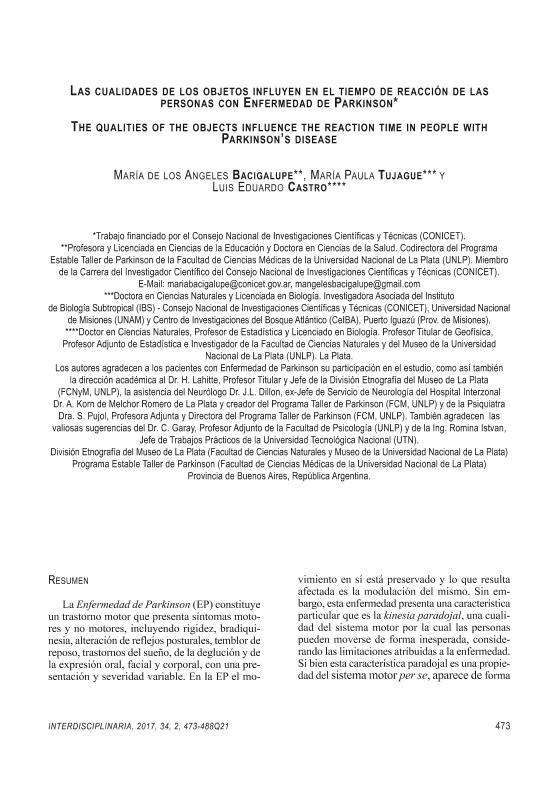Artículo
La Enfermedad de Parkinson (EP) constituye un trastorno motor que presenta síntomas motores y no- motores, incluyendo rigidez, bradiquinesia, alteración de reflejos posturales, temblor de reposo, trastornos del sueño, de la deglución y de la expresión oral, facial y corporal, con una presentación y severidad variable. En la EP el movimiento per se está preservado y lo que está afectada es la modulación del mismo. Sin embargo, esta enfermedad presenta una característica particular que es la kinesia paradojal, una cualidad del sistema motor por la cual las personas pueden moverse de forma inesperada, considerando las limitaciones atribuidas a la enfermedad. Esta característica paradojal es más notoria en los trastornos del movimiento que en el comportamiento motor sano y se asocia a los estímulos ambientales. Desarrollamos un estudio controlado de generalización limitada utilizando una aplicación informática con el propósito de evaluar el efecto de las affordances (un recurso ambiental que provee al individuo una oportunidad de comportarse) sobre el tiempo de reacción en un grupo de personas con EP y un grupo control. Los sujetos con EP presentaron un mayor tiempo de reacción que los controles pero también mostraron aprendizaje a lo largo de la tarea y una mayor sensibilidad al efecto sensorial de compatibilidad (p≤0,05). Los resultados obtenidos nos permiten formular hipótesis sobre los efectos paradójicos que el ambiente puede ejercer al combinarse con las potencialidades de personas con EP. Parkinson’s disease (PD) is a movement disorder with motor and non-motor symptoms, including rigidity, bradykinesia, postural instability, resting tremor,sleep disorders, difficulty swallowing, vegetative symptoms, speech problems and body and facial expression disturbances. Symptoms and disease severity are variable across the patients. Besides, the motion is preserved but the problems of modulation hinder its expression. However, the disease has a particular characteristic called paradoxical kinesia, a quality of the motor system by which people is able to unexpectedly move, contrarily to what is commonly expected for people suffering the inabilities of the disease. Although this paradoxical property is a property of the motor system per se, it is more apparent in movement disorders than in healthy motor behavior and is associated with the environmental stimuli. Several scientific reports have proposed that instead of having movement and perception systems separately, they are integrated in a called action-perception system. Besides, researchers have shown that the environmental scenarios have action properties in relation to this actor actionperception system. For example, a ball in the air has the property of catchability in relation to the perception of the individual, which, in turn, is related to his / her movement. This is called affordance, an environmental resource which provides the individual an opportunity to behave. An affordance represents a relationship between the individual action-perception system with the environmental qualities or learning contexts. We develop a controlled study with limited generalization using a computational tool to evaluate the effect of affordances on reaction time in a group of people with PD and a control group. In each trial an arrow indicating a given direction (right or left) was superposed to a previously displayed image of a frying pan with a handle directed to the right or the left side of the screen. Participants were told to press a key of the side of the keyboard that matches with the arrow direction. It was supposed that the direction of the handle would play the role of an affordance to the perception of the individual; therefore participants could find a conflict between directions of the arrow and the handle. Trial conditions could be two: (a) Compatibility: the directions of the arrow and the handle matched and (b) Incompatibility: those directions did not match. Learning was defined by the decrease of reaction time along the trials. We used a Generalized Linear Model (GLM) to explore the relationship between variables and Generalized Linear Mixed Model with repeated measures (MGLM) to model the incidence ofsuccessive trials on reaction time. The complete sample included 1050 trials from 4 PD patients and 4 controlsubjects. Our resultsshowed that (a) reaction times increased with the presence of PD and age of subjects, (b) there was a high incidence of repetition of trials on reaction times of PD and control subjects, and (c) the compatibility between the stimulus and the image affected reaction time on PD patients exclusively. These results indicate that PD patients were able to learn along trials and this learning was favored by an appropriated sensorial arrangement of the stimuli or compatibility effect. Our results let us hypothesize about the paradoxical effects that the environment can exert on people with PD by its combination with their potentialities. Compatibility trials in our study represent appropriate arrangement of stimuli that have been proven to be necessary for the occurrence of paradoxical kinesia. Given that possibility, we can generate learning contexts to help people with PD to develop these behavioral phenomena in order to improve their movement, their relation with their environment and also their quality of life.
Las cualidades de los objetos influyen en el tiempo de reacción de las personas con Enfermedad de Parkinson
Título:
The qualities of the objects influence the reaction time in people with
Parkinson’s disease
Fecha de publicación:
03/2017
Editorial:
Centro Interamericano de Investigaciones Psicológicas y Ciencias Afines
Revista:
Interdisciplinaria
ISSN:
0325-8203
e-ISSN:
1668-7027
Idioma:
Español
Tipo de recurso:
Artículo publicado
Clasificación temática:
Resumen
Palabras clave:
Kinesia Paradojal
,
Affordances
,
Enfermedad de Parkinson
,
Ambiente
,
Aprendizaje
Archivos asociados
Licencia
Identificadores
Colecciones
Articulos(IBS)
Articulos de INSTITUTO DE BIOLOGIA SUBTROPICAL
Articulos de INSTITUTO DE BIOLOGIA SUBTROPICAL
Citación
Bacigalupe, Maria de Los Angeles; Tujague, María Paula; Castro, Luis Eduardo; Las cualidades de los objetos influyen en el tiempo de reacción de las personas con Enfermedad de Parkinson; Centro Interamericano de Investigaciones Psicológicas y Ciencias Afines; Interdisciplinaria; 34; 2; 3-2017; 473-488
Compartir




